 |
|||||||||
Music Webmaster
Len Mullenger:
Len@musicweb-international.com
|
Classical Editor: Rob
Barnett
Music Webmaster |
||||||||||||||||||||||||||||||||||||||||||||
CD-ROM review BEETHOVEN Sonatas Op. 22, 26, 53 (Waldstein)
Maurizio Pollini (piano)
Deutsche Grammophon 435 472-2 (CD-pluscore) [65'34"]
Save around 22% with
Crotchet
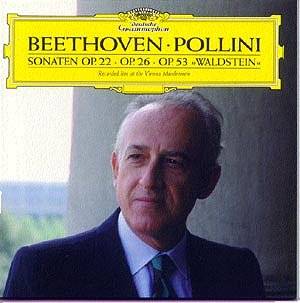
This is a pioneering CD-ROM production. Pollini's performances were recorded live at the Vienna Musikverein in January 1997. They are of the high standards to be expected from this pianist and they are well recorded.
The CD was released the following year, with the additional interest of pluscore features designed to increase listening pleasure and to help students and teachers. There are detailed interactive musical analyses, linked to short passages which can be played separately, illustrated articles as we have become used to with the BBC Music Magazine CDs, and even score editing facilities. The score passes in front of your eyes with a synchronised playing cursor and the pages turn at the right moment.
It is a recommendable CD, even without the computer capabilities needed for making use of all these additional facilities, and I have thought it worth bringing to notice whilst reviewing an interactive CD-ROM to introduce Indian Hindustani Music [q.v. India Musica]
Reviewer
Peter Grahame Woolf

BEETHOVEN: Symphony No: 9 'Choral'. Aase Nordmo Lovberg, Christa Ludwig, Waldemar Kmentt, Hans Hotter. Philharmonia Orchestra Otto Klemperer.
Testament SBT 1177 70m. ADD (Recorded in 1958).
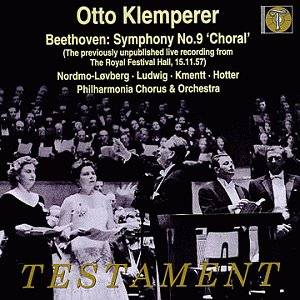
This is quite a stark reminder of the shattering differences between concert hall performances and live recordings, the latter so much of an event than the former. This is a spectacular live relay of a concert that preceded the more famous studio recording, an overt masterpiece long since lauded as one of the finest Ninths around. That this inimitable recording had to lie for over forty years languishing in EMI's vaults is understandable as they would obviously have pressed sales for the studio version but the neglect is unforgivable considering the unhallowed greatness of Klemperer's live conducting.
So much happens in this First Movement, there is such an amount of tension that one is almost left breathless by the constantly rising syncopations and powerful declamations of the playing. I was especially taken by the Second movement's inimitable drive and passion; the 'Feast of Bacchus' is indeed something else. The Philharmonia are a constant marvel throughout with strings in absolute unison whilst the horns (presumably led by Alan Civil) having one of their field days.
This Adagio molto is astonishingly quick for Klemperer at just 15 minutes it knocks almost a minute off the studio recording done a week later, here the thrilling beauty of the performance shines like burnished copper. With that glorious Finale we are indeed on Klemperer's home ground, a constant prayer of unforgettable thrust and momentum. He sails through the opening passage with astonishing vigour and the famous 'Joy' theme is perfectly phrased, just the right amount of pathos and no over gorging here.
All soloists accredit themselves well enough especially the deep bass of Hans Hotter and the women's team of Aase Nordmo Lovberg and Christa Ludwig are indeed in fine voice. This inaugural concert for the Philharmonia Chorus was an outstanding success with their contribution shining out as an authorative and indeed quite masterly. I cannot overstate the importance of this historic reading and it is indeed a joy that it is available once again. Klemperer's live relay takes its place alongside Furtwangler's justly famous account of seven years earlier but this one is accorded better sound and is considerable better played. A must-have, for all Beethoven devotees and more than that.
Reviewer
Gerald Fenech
Performance:

Sound:

Harrison BIRTWISTLE Harrison's Clocks
Joanna MacGregor, piano.
Sound Circus SC004. 26'18"
Order the CD from www.soundcircus.com
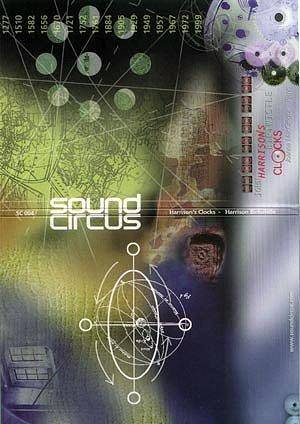
This is one of the most important piano works to have appeared towards the end of the 20th century. After Joanna MacGregor's exclusive rights expire, every aspiring new music pianist will tackle these five pieces, and they will take their place in the 2000 piano repertoire alongside the Ligeti studies, which seemed so impossible at first and are now standard repertoire. There will be other recordings of Harrison's Clocks, but this is a worthy first.They were inspired by the Sobel book Longitude, about the painfully prolonged gestation of John Harrison's sea clocks, now preserved at Greenwich; and the link with Harrison Birtwistle's shared name. There are five substantial pieces, each starting with a rush of notes down to the bottom of the keyboard. In Clock I irregular contrary motion and staccato figures are deliberately out of phase. Next a mechanical fantasy with an alarm bell. Clock III variously combines six figures in pairs. Clock IV introduces each of its four sections by repeating the opening signal of the whole work. The last is a toccata with reversed delays between the hands, ending, as each piece does, 'because the clock-spring has broken down', as explained in Stephen Pruslin's helpful notes.
Heard without worrying about all that, they are fascinating and exhilarating virtuoso display pieces. The performances by Joanna MacGregor, and recording, at Dartington, are impeccable, mind-bogglingly so. (Her performance in the Proms was reviewed by S&H, August '99)
Jewel cases seem to be on the way out? In a slimline cardboard case, slender for storage in bulging collections, the presentation and artwork are delightful, save only for not resisting the temptation to compromise legibility by fashionable over-printing; no matter, reading all the information is worth the effort! Naughty (and unnecessary) to suppress the total duration, revealed on my CD player - only afterwards did I spot that the individual timings are given, in tiny print, to be found around the CD when it is replaced in the case!
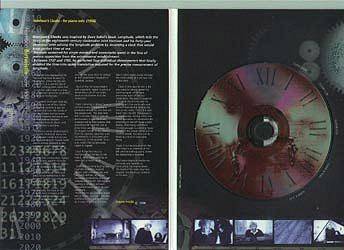
Sound Circus CDs are mid-price, and this is one to play over and over again, so complex and swift is the musical thought. If this latest release on Joanna MacGregor's own label enjoys the success it deserves, perhaps a recording of Birtwistle's piano concerto, which Joanna MacGregor premiered, may follow?
Enjoyment is enhanced immeasurably by listening with the inexpensive score (Boosey&Hawkes). Although it requires a consummate pianist and musical mathematician to get round these fiendishly complex constructions at the keyboard, exploring some of the patterns with the score (if only at quarter speed and one hand at a time) offers a window into creativity!
Reviewer
Peter Grahame Woolf

BRITTEN Paul Bunyan Royal Opera Chorus & Orchestra, Hickox
Chandos CHAN 9781(2) [63.29][47.02]

Save around 22% with
Crotchet
Amazon UK
Amazon US
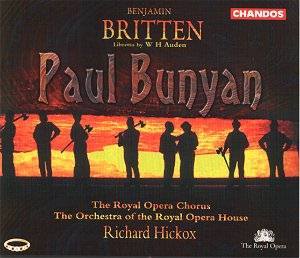
Narrator
Paul Bunyan
Johnny Inkslinger
Tiny
Hot Biscuit Slim
Sam Sharkey
Ben Benny
Hel Helson
John Shears
Fido
Moppet
PoppetPeter Coleman-Wright baritone
Kenneth Cranham speaker
Kurt Streit tenor
Susan Gritton soprano
Timothy Robinson tenor
Francis Egerton tenor
Graeme Broadbent baritone
Jeremy White bass
Roderick Earle bass
Lilian Watson soprano
Pamela Helen Stephen mezzo
Leah-Marion Jones mezzoThis is a belated first complete recording of Britten's American choral operetta, which the composer withdrew after its New York premiere in 1941. I have had mixed responses to it since its exhumation in the '70s, with a broadcast and eventual successful staging at Snape Maltings shortly before Britten died.
I have seen it twice, at Dulwich College and not long afterwards by the Royal Opera in exile. This recording comes from their revival at the rebuilt Sadlers Wells. I have reservations about it as a fully professional piece, and these remain having heard this quality recording. I enjoy quite a lot of the text and some of the music, but it is not out of Britten's top drawer, although a lot does shine through from time to time.
I remain convinced that it is best treated as a school show and can do no better than quote from my June 1996 review in Guide Magazine:
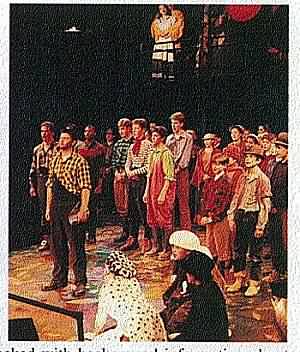
Performance at Dulwich |
|
This recording is produced with evident devotion and accompanied by a 160-page booklet containing numerous photos from the Royal Opera production. But I persist in finding the chorus being trees, and solo singers geese and animals rather twee here and sometimes a little embarrassing (though I have no such problems in Ravel or Janacek!) and the disembodied voice of the eponymous giant is just too ordinary for me. Susan Gritton as Paul Bunyan's daughter Tiny sings sweetly, and all the characters are well taken, if sometimes over-loud for home listening. Full orchestra really has nothing over the school stage band, and does not make up for the lack of intimacy, whether in the theatre or at home.
There will be quite other opinions, and this significant recorded addition to the Britten canon should be reviewed also by someone else, who might approach it more open-mindedly. Hear it for yourself, and do not be put off by my cool rating at

Reviewer
Peter Grahame Woolf

BUSONI: Piano Concerto Op. 39. Marc Andre' Hamelin: Piano, City of Birmingham Symphony Orchestra and Chorus Mark Elder
Hyperion CDA67143 74m DDD.
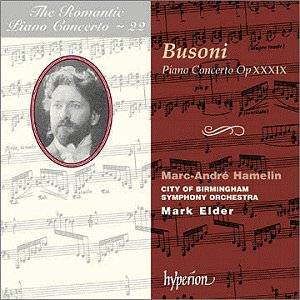
Probably the most important and singular release of this year, this Busoni Concerto would definitely have made it for the Gramophone Awards. . It is indeed a suitable jewel in the crown of Hyperion's Romantic Piano Concerto and continues to confirm the superb enterprising brilliance of this series.
The latest issues were not really memorable, Kullak, Dreyschock, Brull, a sound coupling but nothing overtly sensational, the Busoni definitely is and more besides. As Michael Spring espouses in his introduction, Busoni's reputation as a composer has suffered considerably as he is mainly remembered as a colossal pianist. John Ogdon's recording with Revenaugh has been the standard recommendation of this work for decades and it was the double LP Concert Classics set that kept me constant company when listening (most of the time open-mouthed) to this fabulous recording. Hamelin is the supreme virtuoso, from that titanic piano entry to the devilish fingerwork of the Pezzo giocoso through to the divinity of the cantico. Occasionally the sheer fantasy of Ogdon's playing is captivating but constantly I found myself returning to Hamelin's unobtrusive virtuosity especially with a recording that confirms the Symphony Hall's fabled acoustic. Hamelin's Prologo e Introito is sublime with some dazzling piano playing and an orchestral contribution of great beauty especially in the 'Pastorale' conclusion (Ronald Stevenson). The central movements are also quite winningly done especially the three-movement Pezzo giocoso, a true display of fearsome virtuosity and magnificent genius. Comparing Ogdon and Hamelin is difficult, I am a great fan of the former but the dash and polish of Hamelin is also magnificent. Tarantella is also quite fantastic with a full-throated orchestral accompaniment coaxed along with panache by Elder. The concluding pages of that movement are utterly absorbing, power and harmony make strange bedfellows but all is consumed in the final movement of Babylonian proportions (Stevenson again). It is a question of the futility of life almost reminiscent of Mahler's magnificent Eighth Symphony with a chorus of unhallowed beauty rising alongside harmonic shifts. Both versions are quite flawless here although Hyperion has the better recording and Ogden's is now beginning to show its age. I did not care much for the remastered Ogdon, indeed I prefer the wholesome rounded sound of the LPs, a crisp alternative to the CD. Ronald Stevenson's outstanding booklet note is reproduced for the benefit of all and was an awesome eye-opener for me; it will definitely be for those who buy this disc. Crystal clear recording and outstanding presentation continue to add to the allure of this spectacular release. However it should definitely redefine the status of this superb concerto as one of the most important this century.
MULTAE TERRICOLIS LINGUAE, COELESTIBUS UNA
Reviewer
Gerald Fenech

John CAMERON (b.1944) Missa Celtica (With texts from 6th to 11th Century Ireland and Wales; 16th to 19th century Scotland, Brittany and Cornwall, and the Ordinary of the Mass. Original adaptations and lyrics: John Cameron)
Máire Ni Chathasaigh (folk singer and Irish harp); Lindsay Wagstaff (soprano); Emmanuel Lawler (Gaelic tenor); John Bowley (Latin tenor); Michael McGoldrich (uillean pipes) The Choir of New College Oxford and the English Chamber Orchestra conducted by the composer
ERATO 3984-25494-2 [66:20]
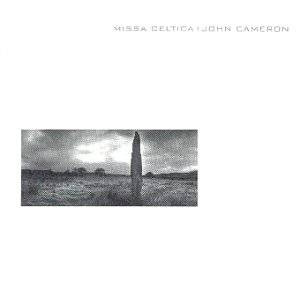
Blest be the man from the island of Colum Cille
Bringing the word to the lands in the eastI enjoyed this music immensely; in fact I would go so far as to say that this is my British Music (or, perhaps, I should say Irish) CD of the year. John Cameron has written a glorious, melodic, accessible and often deeply moving celebration of the passing back of the word of Christianity, during the dark ages after the fall of the Roman Empire, back from the havens of learning that were the abbeys of Ireland, isolated on the north-west tip of Europe. Missa Celtica is the story of the lives and journeys of the Celtic Saints in the 6th and 7th centuries, in particular Collumcille to Iona and Scotland, Aiden to Lindisfarne and Northumbria, and Columbanus and Gallus to Luxeuil, Lake Constance and Lombardy.
John Cameron read History and Music at Corpus Christi College Cambridge. He has had many successes in many fields: Jazz, Pop and film and television work (including writing over 40 film scores including: Kes, A Touch off Class and Black Beauty). His work on José Carreras' 'Passion' (where he was executive music director and principal arranger) led him eventually back to Cambridge and the comparative calm of New College, working with the Choir on their 'Agnus Dei I and II' and 'Early One Morning' albums. In Missa Celtica he has attempted to unify all his many different musical languages. He blends a cappella choral singing in the Ordinary of the Mass: the Kyrie, Gloria, and Sancti Veniti, with Irish and Scots Celtic themes. His choral music is a blending of his 20th-century style with the free psalmodic/organum tradition of early ecclesiastical themes.
Missa Celtica begins with solo uillean pipes. The pipes' theme is developed by the Choir in the Kyrie and the Irish harp intersperses sparkling, brightly flowing figures suggesting the beauty of Erin. A strident and forceful battle hymn on the orchestra based on strongly rhythmic figures, follows. The Gaelic tenor soloist (Emmanuel Lawler) sings gently and eloquently, the beautiful and moving 'Hermit Song' -- 'I wish…for a tiny hut in the wilderness… a lark to sing me the risen sun…And Twelve good men who are sound and true To help me to sing to the Lord.' Dramatic and turbulent music then follows depicting 'Colum's Voyage.'
I could go on to describe all 22 tracks on this CD but I think from what I have written thus far you will have a very good impression of this work. I will therefore just mention two or three movements that particularly impressed me. Of the a capella movements the Gloria is a radiant creation and it is repeated as a joyful almost secular celebration with orchestra. 'Bridget's Descent' (sung warmly with nice articulation by Lindsay Wagstaff) is a lovely hymn for voice and violin praying for the Lord's protection, while 'Let Us Sing Every Day' with pipes and drums prominent is again joyful and strongly rhythmic. 'Collum Cille's Elegy', with its high sustained chords, quiet violin and harp accompaniment to Lawler's rapt delivery is deeply moving. So, too, is the following 'Sanctus/Benedictus Lindisfarne' with the Choir singing a most beautiful setting of the Sanctus followed by a lilting Gaelic rendition of Aiden's calling to Lindisfarne from which I have taken the quotation at the head of this review. This movement is a glorious highlight of the work. Finally, I would mention the radiant ensemble, the closing blessings of 'Pax Deit' that closes this remarkable work.
The singing of soloists, and the New College Choir and the playing of the English Orchestra are practically beyond reproach. Outstanding; a work to marvel at from beginning to end.
Reviewer
Ian Lace

AARON COPLAND An Outdoor Overture ,Appalachian Spring - suite (original version thirteen instruments),Eight Poems of Emily Dickinson * Marni Nixon (soprano) Pacific SO/Keith Clark
rec California 1982, 1986, 1985 REFERENCE RECORDINGS RR-22CD [ 57:40]
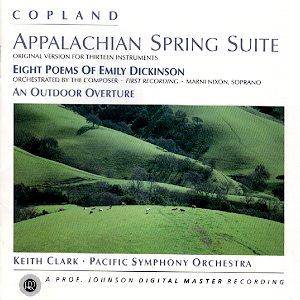
An Outdoor Overture (1938) 8.50 ADD
Appalachian Spring - suite (original version thirteen instruments) (1944) 26.45 DDD
Eight Poems of Emily Dickinson (1950) 22.05 * DDD
This is an unhackneyed and most welcome cross-section of Copland works. While it has been in the catalogue for years it is no disservice that it should be reviewed again. An Outdoor Overture (long a personal favourite in Copland's own CBS-Sony recording) is a vividly lively counterpart to all those defiantly vigorous overtures in which category I also place Arthur Bliss's Edinburgh Overture (worth tracking down folks!), Moeran's Overture for a Masque and Walton's Johannesburg Festival. The Copland breathes the unsullied air of the wide Western expanses but in this performance (enjoyable as it is) misses the fiery engagement of the composer's CBS version.
Appalachian Spring rings and sings with a dewy sense of renewal which is enhanced by the stripped down thirteen instrument version. Art in the service of simplicity is more easily engaged when the forces are of chamber dimensions. If you balance that with the access to greater colouristic range from a variety of instruments and a band of thirteen delivers close to the best of both worlds. I rate this performance very highly although my first preference would be for the complete ballet version.
Finally we come to the very rare Dickinson poems. These are put across with touching sepia-toned affection and good diction by the delightful Marni Nixon. It is interesting that Copland's regard for this poet carried over into the work of his pupil Leo Smit whose collection of Dickinson settings (superbly sung by Rosalind Rees) has recently been released by Bridge. The Copland settings are variously dedicated to some of the great names in American music: David Diamond, Elliott Carter, Alexei Haieff, Juan Orrego Salas, Irving Fine, Lukas Foss and Arthur Berger.
This set will be wanted by every Copland fan and is recommended accordingly.
Reviewer
Rob Barnett

COUPERIN: Harpsichord Works. Liesbeth Hoppen: Pleyel Harpsichord.
Arsis Classics 97013 68m DDD.
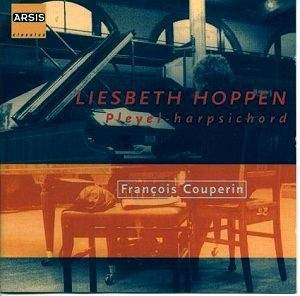
This delightful collection reveals a singular joy in the various sonic capabilities of the Pleyel Harpsichord, a choice instrument that can also double as a small chamber organ and piano. Couperin's works are wonderfully varied and inventive, here we are presented with three short groups of compositions, none lasting over five minutes except the gigantic concluding 'L'Amphibie', a singularly masterful composition of hallowed invention. I listened to the whole disc in a straight run-through on a wet Friday afternoon and the experience is not easily forgotten! The soft sounds of Liesbeth Hoppen's delicate playing touched my heart with spiritual intensity and I was more than once transported to some drawing room in Versailles with Louis XIV in attendance! All twenty-one pieces have something special about them; indeed they are not far off Bach for inspiration and technical bravura. Couperin evidently knew his harpsichord much better than many and was able to produce some marvelously outstanding sounds from the instrument. As mooted earlier I found little to fault in Hoppen's playing, her deft fingerwork brushes aside all technical difficulties while her wonderful playing is akin to the great women harpsichordists such as the legendary Wanda Landowska. It would be hard to recommend any particular piece above others although the wonderful 'Les Tours de Passe-passe' had me almost gasping for breath. Artis' clear recording lends majesty and bloom to the harpsichord and the intimate acoustic seems just right although the sound does get occasionally muddled at the end of the disc. Presentation is a bit on the dull side but otherwise, a lovely disc and one that will be making continuous visits to my CD player especially on the radio*.
Reviewer
Gerald Fenech
Performance:

Sound:

(* Gerald broadcasts on Classical Music in Malta - LM)
DUKELSKY Vladimir. Zéphyr et Flore; Epitaphe. Ilma Achmadeeva (soprano), Netherlands Theatre Choir, Residential Orchestra of the Hague, Gennadi Rozhdestvensky.
Chandos CHAN9766 [DDD] [55' 23"]. Première recordings.
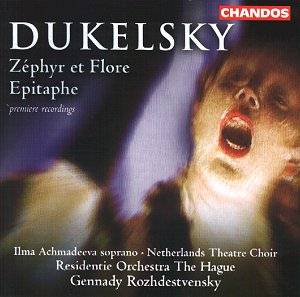
Chandos are to be congratulated for this disc of première recordings. However, Natalya Savkina's booklet notes are inadequate. She omits vital information failing to tell us, for example, that when Dukelsky was in the USA he was known as Vernon Duke and wrote 'pop' songs which have now been taken by Sylvia McNair and Dawn Upshaw.
The ballet, Zéphyr et Flore, appeared in 1925 when the composer was only 22 and was produced by Diaghilev. Poulenc and others remarked on Dukelsky's dependence upon Prokofiev and indeed the older composer promoted his music. The ballet has a few fine moments but most of it is merely pleasant. Savkina refers to the waltz movement as thrilling which my colleagues and I found ordinary. Myaskovsky, the under rated Russian master, said that the theme of the Theme and Variations was 'sweet and reminiscent of youth' which indicates the problem of this work, its immaturity. It has no personal voice and three years later Prokofiev had to help Dukelsky with his Symphony No 1 as the orchestration was poor. This further indicates that he did not work hard under the excellent tutelage of Reinhold Glière.
Epitaphe of 1931 is a better work but still lacks a personal voice or any outstanding music. It sets poems by Osip Mandelstam and would appear to be a memorial to Diaghilev who had died in 1929. It also shows the composer's dislike for the Russian régime and why he eventually became an American citizen. The soprano soloist is excellent as is the choir although one has to say that the material is ordinary, if not poor.
As far as I can tell the performances are good ... the recording certainly is. I think the music is not particularly inspiring but you must make that choice.
Reviewer
David Wright
Performances

Recording

ELGAR & BRIDGE Sonatas Lowri Blake, cello & Iwan Llewelyn-Jones, piano
LOWRI RECORDS 2000 * [55:02]
Edward Elgar: Sonata in E minor, op. 82 (1919 - transcribed for cello and piano by Lowri Blake 1994) / Frank Bridge: Morning Song (1918), Sonata in D minor (1913-17)
Real audio samples and purchase from http://www.lowrirecords.com
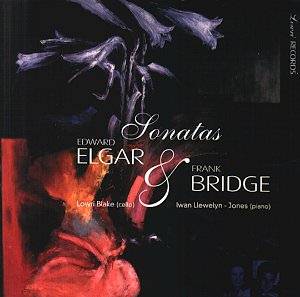
In 1918-1919, at Brinkwells cottage in Sussex, Elgar wrote his final completed major works. The Violin Sonata, op. 82 was followed by the String Quartet in E Minor, the Quintet for Piano and Strings in A Minor and the Cello Concerto, op.85. Perhaps inevitably, given that they were written under the shadow of the Great War, all four works imbued with a deep melancholy. In the notes accompanying this CD, Lowri Blake records on first hearing a concert performance of the Violin Sonata: "The dark, noble and highly evocative Violin Sonata might easily have been written for cello. By the end of the performance I had resolved to play the Violin Sonata myself on the cello…"
A very accomplished musician and singer - for more information about Ms Blake and Lowri Records see my review of The Song of the Black Swan, or visit the web site at http://www.lowrirecords.com - Lowri Blake made the transcription used for this CD herself, first recording it for Radio 3 in 1994. As she says, "Transcribing op.82 for cello was in fact not a difficult task - I simply play the violin part down an octave…" There are also some other few changes, but like Frank's Violin Sonata in A, the work transposes well to the new instrument. It is a work of darkly colour romantic intensity, retaining all it's Elgarian character in transcription, yet inevitably now becoming something of a more intimate companion to the Cello Concerto. The deeper tones of the cello express perhaps a more mature, more profound sense of resignation to loss than the violin, an instrument in the upper registers more inclined more youthfully overwrought passion.
Lowri Blake clearly has a great love of this music, and her playing is always thoughtfully considered, her phrasing flowing with a natural sense of argument and development. Praise is also due for Iwan Llewelyn-Jones sensitive and apposite musicianship. This is a demanding work, and both players give fine performances. It obviously makes most sense to have a version of the sonata in its original form first, but this interpretation shines fresh light into Elgar's melancholy heart, and I am most pleased to be able to include it in my collection.
The disc intelligently links the Elgar with two works from the same period by Frank Bridge. First, Morning Song again composed in the latter stages of the Great War, this short work is a piece of clear and expressive beauty. The cello does indeed sing in this perfectly formed miniature.
Bridge's Sonata in D Minor is in two, rather than three movements, and written over a period of four years from 1913-17, appears to have been something of a struggle for the composer. Here is Bridge between the romanticism of the past, and the more modern style of his later music. The opening Allegro both agitated, yet introspective, the closing Adagio ghostly, the piano in this recording taking a spectral life, as if afforded a glimpse of the next world, the cello voicing almost a frozen incomprehension. Confidently realising the space between notes as much as the notes themselves, Lowri Blake and Lwan Llewelyn-Jones bring an insight to this haunted, impassioned music which crosses the generations to offer a vision of a vanished world. Heartrending, almost unbearably moving, this is very fine music-making indeed. The three works together make an excellent programme, a most commendable and inspired release from this creative new label.
Reviewer
Gary S. Dalkin

Visit the Frank Bridge web pages
Joseph EYBLER Christmas Oratorio Sabine Ritterbusch (sop), Waltraud Hoffmann-Mucher (alto), Harry van Berne (ten), Jelle Draijer (bass) Alsfeder Vokalensemble & Bremer Domchor I Febiarmonici conducted by Wolfgang Helbich
CPO 999 667-2 [70.11]

Save around 22% with
CrotchetAmazon UK
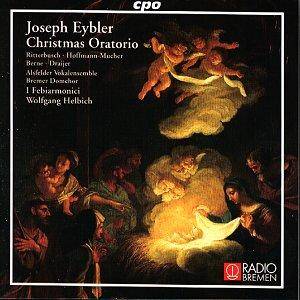
Joseph Eybler was a Viennese composer of the late 18th and 19th centuries. He was a pupil of Johan Georg Albrechtsberger (as were Hummel and Beethoven), and was a respected friend of Mozart and Haydn. He is believed to have had a close involvement with the composing and posthumous completion of Mozart's "Requiem". His Christmas Oratorio "The Shepherds at the Crib in Bethlehem" was his his first major choral work at the age of 29. Its musical style is a synergistic blend of "late baroque" elements (no doubt imbibed from his traditionalist mentor Albrechtsberger) together with the then modern style developed by Haydn and Mozart. Listeners can be grateful to the conductor of this performance, Wolfgang Helbich (Director of Music at Saint Peter's Cathedral in Bremen), whose resaerches have rescued this entrancing work from undesereved obscurity.
The overture open with dark and sombre chords in the minor key, reflecting the shepherds' apprehension and awe on approaching the manger in Bethlehem, but the predominant emotion of the whole work is one of undiluted joy and exultation, alternating with movements of serene contemplation. Certain movements call for special mention: No.4, "Das Kind strecht seinen Arm", contains woodwind playing, especially the melifluous flute obbligato, which forms perfect ensemble with the contralto voice of Waltraud Hoffman-Mucher. No.8, "Er ist's, Gott selbst in Fleischeshulle", and No.16, "Er ist in Bethlehem geboren" are bravura arias for soprano (Sabine Ritterbusch) and bass (Jelle Draijer) respectively, which would merit honourable places in Mozart opera or Haydn oratorio, with exhilarating brass and tympani which Helbich lets fly with unrestrained vigour. The pastorale music, obligatory in 18th century Christmas music, is here provided in the final chorus of Part 1: "Euch ward er geboren" by a particularly robust Chorus of Angels; serene it is, to be sure, but saccharin sentimentality is conspicuously absent.
The finale of the whole work, "Gott sey Ehre in der Hohe", is truly a Gloria in Excelsis of a chorus, set in triple time and performed at a tempo for which "scherzo" is the only possible description. What makes this performance so stimulating and high impact is the uninhibited enthusiasm of the orchestra, soloists and chorus alike, who so brilliantly do service to Helbich's lively, but never rushed, tempi. At the same time, much careful preparation must have gone into the vocal/instrumental and the strings/woodwind/brass & percussion balances, together with extremes of dynamic range, which the recording puts over with full force. This must be an exhilarating work to perform in. Choral societies seeking a shorter work than Handel's "Messiah" or Bach's "Christmas Oratorio" could do well to consider Eybler's work for Christmas performance. Even the final chorus alone would be a fitting climax to any Christmas concert.
Reviewer
Humphrey Smith

GERHARD Roberto: Portraits and Horoscopes Libra; Leo; Gemini; Concert for 8; 3 Impromptus Nieuw Ensemble cond. Ed Spanjaard
Largo 5134 [63'33"]
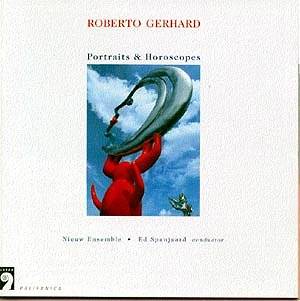
This is an ideal introduction to Roberto Gerhard (1896-1970) for anyone unfortunate enough not to have come across him. He studied in Barcelona with Granados, became a pupil of Schoenberg in 1923, settled in Cambridge in 1939, where he composed his best music. He distrusted analytical notes and his ideal listener was the non-specialist with open ears.
Leo, Libra and the Concert for 8 are written for unusual chamber ensemble combinations which fit exactly the Nieuw Ensemble's unusual line-up, which for this CD includes guitar, mandolin and accordion with more usual instruments. They were featured by the BBC and London Sinfonietta in the 70s, less often more recently. Evocative music, with a succession of ravishing sounds; listener friendly even for those still put off by serialism, which Gerhard uses in a very personal way.
Gemini is for violin and piano, with extra sonorities from the strings inside. The 1950 piano impromptus have Andalusian and Catalan echoes, the third is like some of Schoenberg's piano music, with 'Central European rigour tempered by Iberian warmth' (David Drew/Calum MacDonald).
The Amsterdam based Nieuw Ensemble is one of Europe's finest contemporary music ensembles, and these 1996 recordings are impeccable. Full notes including a year by year biography of this adopted English master. Wholeheartedly recommended.
Reviewer
Peter Grahame Woolf

[See also my reviews in S&H of Roberto Gerhard as featured composer in Musica99 (Strasbourg) and of the Nieuw Ensemble at Huddersfield Festival.]
Cecil Armstrong GIBBS (1889-1960) Dale and Fell - Music for Strings Guildhall Strings directed by Robert Salter
Hyperion CDA67093 [65:00]
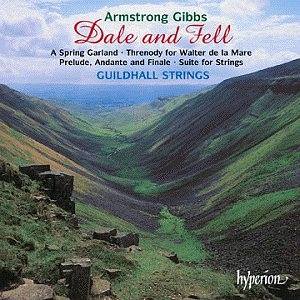
Introduction - The Guildhall Strings
Those who have admired the fine ensemble playing of the Guildhall Strings over the years, especially in the various music festivals up and down the country, will welcome this their first (but hopefully not last) appearance on the Hyperion label. The Guildhall Strings play standing up (except for the three cellists) in a semi-circle creating a freedom of communication impossible in traditional orchestral seating. Since there is no conductor, all the players contribute to the overall shape of the music, as members of a string quartet do. As a Daily Telegraph critic has written, "They are as much a pleasure to watch as to listen to."
Armstrong Gibbs string works on this album
The collection commences with the Prelude, Andante and Finale. This work was originally written by the composer for string orchestra but this version was lost (the only surviving copy is for piano, four hands.) The version on this CD is Lawrence Ashmore's version for Gibbs's original forces in which he underlines the grandeur and scale of Gibbs's music with his rich scoring. Having just returned from leading a Holiday Fellowship (walkers) special interest holiday on Music Appreciation, I very much appreciated Gibbs's music of the Prelude with its marching music. You can hear the pattern of the walkers' feet: the leader striding along purposely and the varied patterns of the other (perhaps not quite so committed) walkers tread. Included on an earlier Marco Polo album of Armstrong Gibbs's music, was the composer's Westmoreland Symphony (1944), a highly personal musical outpouring of personal grief. That mood is sustained through the Andante - a coming to terms with wartime trauma and personal loss culminating, here, in a tormented final climax. The Finale returns us to the bracing outdoors with music marked by constantly changing accents that reminds one of Holst.
Dale and Fell is a short evocative suite. The opening Prelude: The Beck Climb, is appropriately evocative and has a memorable long-breathed tune; the central movement Rest at Noon is a lullaby as the walkers doze under the hot mid-day sun; and the final Over the High Fells is a sturdy descending marching bass with a no-nonsense marching tune.
In 1919, Gibbs was working as a teacher at his old preparatory school in Brighton when he grasped a chance to switch to a full time music career. He was asked to organise a celebration for the retiring headmaster. He hit on the idea of a play with music composed by himself. For the text he turned to Walter de la Mare. De la Mare agreed to write the play and two months later a script called Crossings arrived. Clearly then, Walter de la Mare figured prominently in Gibbs' creative life. When the poet died in June 1956, Gibbs immediately responded with his Thenody for Walter de la Mare - a deeply felt paean that looks back to the sound world of Vaughan Williams's Tallis Fantasia but also to Herbert Howells in similar mood.
A Spring Garland (1937) is a collection of five, two-minute miniatures recalling Peter Warlock's Capriol Suite in style. Each movement is named after country flowers: Kingcup, Dog Violet, Daffodil, Windflower and Tulip. Almayne, the earliest Gibbs work in the programme is a similar work written in an older style. In fact the tune comes from Elizabeth Rogers' Virginal Book of 1656.
The album concludes with the most substantial work in this collection - Suite for Strings completed just one year before Gibbs's death. Containing some of his most sonorous and rich string textures, it is notably lacking in angst. The opening music is strongly reminiscent of Gerald Finzi. His middle movement, A Song of Sleep allows untroubled slumber and his finale, The Promise of Spring, is all ebullience and celebration.
A collection to treasure, proving (if any were necessary) the worth of this unjustly neglected British composer. The Guildhall players deliver performances full of vigour and sensitivity. More Armstrong Gibbs, please, Hyperion.
Reviewer
Ian Lace

BATTLE OF BRITAIN: RON GOODWIN and WILLIAM WALTON. original MGM soundtracks. Goodwin conducted by Goodwin, Walton conducted by Malcolm Arnold
RYKODISC RCD 10747
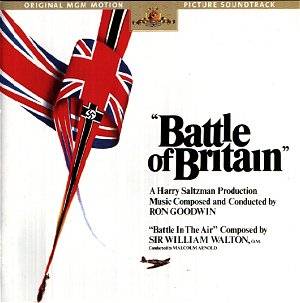
This disc is of considerable interest since it contains the full score provided by Sir William Walton for The Battle of Britain together with the soundtrack actually used in the film which was composed by Ron Goodwin. As film buffs and Walton fans will know the only piece of Walton's score MGM used in its entirety in the 1969 production was the famous Battle in the Air sequence, though, on a recent broadcast, snatches of Walton's Battle of Britain March appeared briefly at the very end of the film.
What of the music itself? The disc allows us to appreciate the two composers' different approaches to the task of providing a score and it must be said that Goodwin is by no means outclassed. True, the Battle of Britain March by Walton is stirring and quintessentially British though it adheres very closely to the chord sequences which make up the Orb and Sceptre March, the March for A History of the English Speaking Peoples and the Granada Prelude of 1968. Nonetheless, it is a splendid theme and a tried and tested formula! Ron Goodwin's Battle of Britain Theme is less regal and noble but conveys a greater sense of urgency and action - the same idea of a vigorous-sounding motif over an insistent and interesting rhythm which made Goodwin's main theme for 633 Squadron such a success. When it comes to the music depicting the Luftwaffe, Goodwin wins hands down with a splendidly idiomatic Teutonic march Aces High replete with oompah brass and glockenspiel. Walton's use of the Siegfried horn call from Wagner's Ring is clever but overused and strangely enough not terribly Germanic, the effect being unaccountably Italianate (the influence of Ischia perhaps): the number Gay Berlin might as well have been called "Racy Rome"!
The informative sleeve notes suggest the brevity of Walton's score must have been a determining factor in its rejection by MGM. There may be some truth in this for the majority of the 55-minute running time of the CD is taken up by the Goodwin score (which provides 19 out if the 28 tracks). As with most soundtrack albums there is a lot of varied repetition of the same material but in this instance the themes are worth hearing again: the transformation by Goodwin of the Trio section of the Aces High March into a nostalgic string threnody in the numbers Work and Play and Threat is a fine example of evocative instrumentation. Walton's score occasionally struck me as an autumnal revisit to the world of Façade, the witty use of existing material (in this case Wagner's horn call) and the bright scoring strangely recalling the composer's early success. From time to time there is a forcible reminder that Malcolm Arnold is the conductor here (the sleeve notes hint that Arnold may have actually contributed to the score): listen to the very opening of the March Introduction and the close of the Battle in the Air track with its unmistakably Arnoldian chromatically rising passages. Perhaps Walton was nervous about contributing his first film score since Richard III in 1956 and sought advice from the prolific Arnold which rubbed off in the orchestration.
In sum, this CD contains fine examples of important film repertoire. The performances are also authentic (always a bonus in my view). Walton fans need not hesitate, though to be brutally honest I feel the Battle in the Air and March stand head and shoulders above the other pieces in the score. Just as Malcolm Arnold's film music sums up the very essence of Britain in the 1950s, so Ron Goodwin's atmospheric score captures the world of British cinema in the 1960s in a very special way. The sound is remarkably vivid considering the disc is made up from three reels which, until 1990, were stored in recording engineer Eric Tomlinson's damp garage! The artwork is excellent too with many stills taken from the film in the accompanying booklet and a Spitfire's red circle reproduced on the CD itself! Not just for nostalgia buffs, this release should bring pleasure to admirers of the work of Goodwin and Walton and quality British film music in general.
Reviewer
Paul Conway

Arthur HONEGGER (1892-1955)
Pacific 231
Rugby
Symphony No 1
Symphony No. 2 "for strings"
Symphony No. 3 "Liturgique"
Symphony No. 4 "Deliciae Basilienses"
Symphony No. 5 "Di tre re"Symphonieorchester des Bayerischen Rundfunks conducted by Charles Dutoit
ULTIMA/ERATO 3984-21340-2 2CDs bargain price (Note: These recordings were made in 1984 and 1986 and reissued in this format in 1998)
BARGAIN OF THE MONTH
Save around 22% with
Crotchet
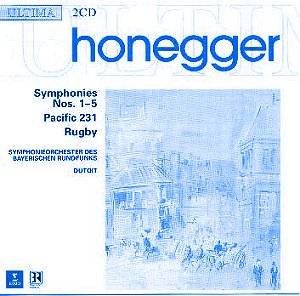
Here is another jewel in the Ultima series of super budget bargains and these are recommended recordings to boot!
Pacific 231 (1923) is Honegger's best known work [its proper name and style is: Pacific 2.3.1 (Symphonic Movement No. 1)]. It is now regarded by many as rather passé which is a shame because it is one of the composer's most original, radical and meticulously constructed works.
"I have always been passionately fond of locomotives. For me they are living beings and I love them as others love women or horses," commented Honegger. "What I was after was not the imitation of locomotive noises but the translation of a visual impression and a physical delight through a musical construction. It is based on an objective contemplation: the tranquil breathing of the machine in repose, the effort of getting up steam, then the gradual picking up of speed, culminating in the lyrical, engrossing vision of a train weighing 300 tons hurtling through the night at 75 miles an hour. I chose as my subject the locomotive of the "Pacific" type, with the symbol 231, used for heavy, high-speed trains…"
Another short work of impressive rhythmic imagination that caught the public's admiration was Rugby. Honegger wrote of it: "I'm very fond of football, but rugby is closer to my heart. It seems to me more spontaneous, more direct, closer to Nature than football, which is more scientific. Certainly I am not insensible to football's carefully prepared moves, but I am keenly attracted to rugby's rhythm, which is savage, abrupt, chaotic and desperate. It would be wrong to consider my piece as programme music. It simply tries to describe in musical language the game's attacks and counterattacks, and the rhythm and colour of a match…"
I will just briefly touch on the five symphonies. Honegger's energetic, youthful First Symphony was commissioned to celebrate the Boston Symphony Orchestra's jubilee. The opening movement has an abrupt impetuosity, while the Adagio is a slow heart-felt procession. After all the high-spirits, the Finale concludes in ethereal serenity. The Second World War left its mark on the Second Symphony (1941), a work for string orchestra, which is sombre and full of mourning. The basic character of the Third Symphony (1945-46) "Liturgique" is quite similar. The headings of the movements come from the Requiem Mass. Honegger described this symphony as: "…a drama acted out either in real or symbolic terms by three characters: misfortune, fortune, and man."
In contrast the Fourth Symphony is serene; its subtitle "Deliciae Basiliensis" means The Delights of Basle and it was written after the composer had spent a carefree holiday in Switzerland. There is a chamber music like sound and quality about this work. Conversely Honegger reverts to a large orchestra for the Fifth Symphony (1950). Despite some optimistic passages recalled from earlier works, the prevailing tone is one of pessimistic resignation. At the time of this work Honegger was suffering insomnia and increasingly bad health after his heart attack in 1947. (He died on November 27th 1955.) "To get rid of my gloomy thoughts I wrote them down…these turned into sketches! After I joined them together, I realised they made a symphony.."
As I said at the beginning of this review, Dutoit's performances of all these works have received good reviews and I would add that at the bargain Ultima price all admirers of Honegger should snap this album up before it disappears.
Reviewer
Ian Lace

ARTHUR HONEGGER Les Miserables (suite, 1933) La roue (overture, 1922) Mermoz (2 suites, 1943) Napoleon (suite, original version, 1926-7)The CSR Symphony Orchestra (Bratislava) conducted by Adriano
MARCO POLO 8.223134
Combined Book and CD Review
The CD
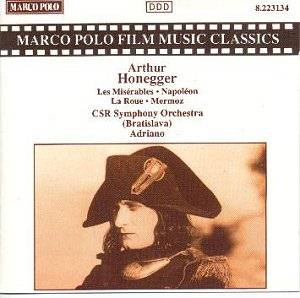
(note: this is not a new release; the recording was made in 1987)
This album has been in my collection for some time but it seemed appropriate to review it now because we are carrying a review of a new book on the composer and Music on the Web is also carrying reviews of more music by Honegger this month.
Arthur Honegger (1892-1955), one of the greatest of twentieth century composers, made a very significant contribution to film music during the course of some 30 years from his scores for Abel Gance's La Roue in 1922 and Napoléon in 1926, to his last work in the genre in 1951. He scored for a total of forty films. Honegger arranged some of his film music for the concert hall. Probably his most famous work, Pacific 231 (the name of a locomotive - he was passionately interested in railways, including model railways) was originally composed as a concert piece but was later used in a film about the train.
Les Misérables begins with the sombre 'Générique', intense and dramatic almost a funeral march but it soon develops into a lighter veined and appealing pastoral accompaniment for Jean Valjean on his travels. 'Dans les Égouts' (In the sewers) is another dark expression of superhuman effort and is based on a continuous rhythm of pairs of eighth-notes. 'Music chez Gillenormand', using an ensemble of string octet and solo wind, recreates the chamber character of this contrastingly cheerful rollicking piece. Clarinet and trumpet play a picturesque duet in this charming interlude. 'La mort de Valjean' (The Death of Valjean) is a lovely deeply-felt cue employing trumpet and saxophone in the melodic line, with a continually modulating two chord ostinato figure passing from piano to strings. The final L'émeute (The riot) is epic battle music.
La Roue (The Wheel) is something of a misassembly of scraps of material from the music Honegger wrote for Abel Gance's film. As one might deduce from the short piece's rhythmic patterns, the film is about railways and the melodramatic material suggests dirty doings afoot(plate).
Much more significant and impressive is Honegger's splendid music for Mermoz (1942). It is one of the best scores Honegger wrote for the cinema. The film was about the French aviator Jean Mermoz. It is interesting to compare this score with that of Franz Waxman's for Billy Wilder's marvelous The Spirit of St Louis for there is a commonality between the two screenplays. The suite is in two movements: La Traversée des Andes (Crossing the Andes) and Le Vol sur l'Atlantique (The Flight over the Atlantic). The music is vividly evocative. You can visualise the swirling of the air around the aircraft and its progress through the clouds over the Andes and the lightning flashes around the little plane as it gropes its way through the storm over the Atalantic. This is imaginative evocative writing at its very best. I would commend every student of film music to listen to this work.
Honegger's Suite from Napoléon consists of very varied material. The opening 'Calme' is an idyll in the style of the composer's highly popular Pastorale d'été.
'La Romance de Violine' is romantic pastiche; a salon piece. 'Danse des Enfants' is a buoyant folksong-like trifle in the manner of Messager. The tone changes in 'Interlude and Finale' which starts out sounding darkly impressionistic before revolutionary songs intrude. The 'Chaconne de L'Impératrice' is more of a slow rather sultry waltz that nods towards Fauré or Messager. 'Napoléon' sounds appropriately imposing, indomitable and regal. Adriano makes much more of 'Les Ombres' (The shadows) than Marius Constant on a rival Erato Ultima CD. This is a mysterious and atmospheric piece for strings and mid-distanced trumpet suggesting the call of duty before an approaching storm. The final 'Les Mendiants de la Gloire' (The Beggars of Glory) brings the suite and the album to a magnificent and glorious conclusion as Napoleon's army marches off to Italy to La Marseillese in a peroration that rivals that of Tchaikovsky's 1812.
Fabulous
Reviewer
Ian Lace
This CD is also reviewed by Didier C. Deutsch
ARTHUR HONEGGER By Harry Halbreich (Translated by Roger Nichols) Amadeus Press 680 pages
£32:50 (Amazon UK £24.54)
USA $44:95 (Amazon US $31.47)
This important book traces the life of this great twentieth century composer and analyses all his many works written in every genre. Every one of his 43 film scores is discussed in detail together with his many works for the theatre and radio plus his light music as well as his more "serious works". A much more detailed review of this book appears on our companion site Classical Music on the WebReviewer
Ian Lace

ARTHUR HONEGGER Les Miserables from the 1933 filmThe Slovak Radio Symphony Orchestra (Bratislava) conducted by Adriano
MARCO POLO 8.223181 [58:55]
Only £4.99 at Amazon UK
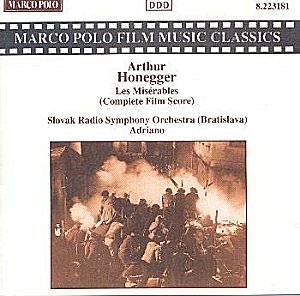
It was Miklós Rózsa who was so deeply impressed with this score that he urged Honegger to make a suite out of the music. "It was as good as anything he had written, and was worthy to stand on its own…It was dramatic and lyrical, and so much in his individual style that you would have known who the composer was even without seeing his name in the titles," Rózsa wrote of it. Eventually, Honegger followed Rózsa's advice and arranged some of the music from Les Misérables into a five-movement suite. This 19-minute suite was recorded by Adriano -- on MARCO POLO 8.223134. It was reviewed on this site last month (November 1999). This follow-up recording of the complete score, lasting practically an hour, was made two years later in 1989.
[Charles Koechlin also considered Les Misérables "undoubtedly one of the best film scores hitherto created.]
The score begins with the sombre 'Générique' (Main Title), intense and dramatic almost a funeral march; in this recording it is much extended over the previous version. The slow descending, resigned (in places even weary) march motif is related to the convicts. It's opposite is the ascending motif associated with the nobility and kindness of Jean Valjean and this is at once apparent in the more optimistic tread of 'Jean Valjean sur la route' with its appealing pastoral inflections and expressive saxophone figures (notwithstanding some shadowy material).
The score has its share of surprises. Quoting Adriano's informative notes (excellent although Marco Polo could have given us translations of the movement titles), "Honegger displays a curious experimental aspect in 'La foire à Montfermeill' where the reprise of the "source" folk music piece [sounding innocent and child-like with its accordion ostinato] has superimposed "psychological" glisssandi from trombones, tremoli, glissandi and col legno effects from the strings [striking the strings with the stick of the bow instead of playing on them with the hair] supported by the percussion. These effects are used to illustrate little Cosette's frightful nocturnal experience in the woods, before meeting Jean Valjean for the first time. 'Une tempête sous un crâne' is another movement of value and particularly dramatic in its impact: it emphasises a longer "conscience struggle" monologue by Jean Valjean." Music of compassion battles with darker material, here, collecting some grinding dissonances, starkly agitated figures and lonely remote material on the way. A truly impressive movement.
'Fantine' is almost unbearably poignant, music that pleads desperately and again the saxophone is used most expressively.
In opposition to the general morbidly oppressive atmosphere of this score there is the more buoyant pastoral/romantic music that celebrates the love between Cosette and Marius 'Music chez Gillenormand', using an ensemble of string octet and solo wind, recreates the chamber character of this cheerful rollicking piece. Clarinet and trumpet play a picturesque duet in this charming interlude.
When the narrative reaches Paris, 'L'emeute' (the riot) is epic revolutionary music and 'L'assuat' is very thrilling with Adriano's inspired insertion of an explosion effect for percussion instruments (an extra part for military drums was also found appropriate).
Dans les Égouts' (In the sewers) is a dark expression of superhuman effort and is based on a continuous rhythm of pairs of eighth-notes. 'La mort de Valjean' (The Death of Valjean) is a lovely deeply-felt cue, an apotheosis of the Valjean theme that employs trumpet and saxophone in the melodic line, with a continually modulating two chord ostinato figure passing from piano to strings.
A score that dwells a lot in dark places but is nevertheless a classic which adventurous film music enthusiasts should not ignore. Adriano gives a totally committed and excellent
performance
Reviewer
Ian Lace

ARTHUR HONEGGER Mayerling, Regain (suite I, 1937) Regain (suite II, 1937) Le demon de l'Himalaya (2 symphonic movements, 1935) The Slovak Radio Symphony Orchestra (Bratislava) conducted by Adriano
Marco Polo 8.223467 [59:51]
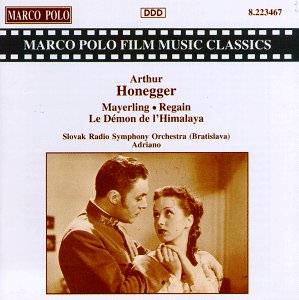
Arthur Honegger (1892-1955) was a great film enthusiast. He was often seen on the set during filming and he had astonishingly advanced ideas on the role of film music. As Adriano writes, in his informative notes for this album, "…He regarded the ideal film score as a distinct component in a unified medium, despising clumsy attempts at cartoon synchronisation with movement on the screen, and looking forward to films that might not so much be supplied with music as inspired by it."
Mayerling (1936) starred Charles Boyer and Danielle Darrieux both unconvincing in the roles of Archduke Rudolf and Marie Vetsera who committed joint suicide rather than deny their impossible love. [This true story, that rocked the Austro-Hungarian Empire, has never been satisfactorily filmed, the later Omar Sharif and Catherine Deneuve was equally limp.] Honegger's music was one of its better elements. From the score, the composer fashioned a four-movement suite, full of romantic/Viennese colour. The opening movement is regal but tragic and it includes a quotation from Strauss's waltz, Wine Women and Song. The shadows fall over 'Jardin' which is otherwise a beautiful evocation of rippling waters and fountains and birdsong in a scented, colourful garden. The final movement is very intense and full of pathos in a desperate post-romantic harmonic style. Two shots ring out over the orchestra, emphasising the tragedy.
Marcel Pagnol's film Regain (Aftermath) (1938), starred the great Fernandel. It was set in Provence and it was about the deserted village of Aubignane and its infertile land, eventually brought to prosperity again through the united forces of a poacher and a cabaret girl. Panturle has taken her away from Gédémus, a good hearted but simple-minded knife grinder, who had bought her after she had been raped by some charcoal burners. His love for Arsule is the driving force behind his patient and honest labour.
From the score, Honegger produced two short suites. Both are recorded here. Suite I opens with a brisk, no-nonsense march. This Le Panturle movement also includes quite brutal and dissonant material. The 'Hiver' (Winter) and 'Printemps' (Spring) movements are spellbinding evocations, with winter's chill grip feeling harsh and relentless with only a chink of warmth emanating from a romantic motif, while the slow release of Spring gives the feeling of new life sprouting all around. The beautiful dialogue for clarinet and saxophone is the highlight of this ebullient movement. But the high point of this suite is Gédémus, le rémouler (Gédémus, the knife-grinder). This is a miniature tour-de-force as the music sparks like a Catherine Wheel to realistically evoke the Fernandel character (personified by a comical limping bassoon figure) at work. The suite closes with music ('Regain') that is as broad and majestic as the countryside yet also determined and as down-to-earth as its people. Suite II opens with a simple but very appealing rustic and child-like melody - Chanson d'Aubignane with its saxophone solo and goes on to 'Nocturne', surely one of Honegger's loveliest evocations with strings and woods singing over a pulsating ostinato. A scented picture this - one might imagine a glorious sunset with enraptured birdsong, the music lilting almost a lullaby. The rapturous mood is shattered by the material of the following cue 'Nuits dans la grange - Eté' that suggests a storm with shrieking gales, bolts of lightning and thunderclaps but peace is restored with the music returning to the mood of the Nocturne. Once more, the saxophone makes an indelible appearance. 'Le soc' brings the suite to a rather pompous conclusion. It has a short trio that vividly evokes a merry-go-round at at the village fair. The Regain score is one of Honegger's masterpieces for the cinema.
Le Démon de l'Himalaya (The Demon of the Himalayas) (1934/35) took its inspiration from a successful expedition to the Himalayas in 1930. The members of the expedition were pressed into service to act in this film. It tells the story of Norman an ethnologist, who has in his possession the mask of the mountain demon Kali Mata, a spirit that prevents ordinary mortals from climbing the Himalayan peaks against the will of the gods of Tibet. Norman's fiancée, who remains at home, smashes the mask enabling the expedition to overcome its obstacles. Honegger was inspired to write a powerfully evocative score for this film in the spirit of his music for Mermoz (reviewed on Film Music on the Web this month). From his score, a two movement suite was developed. Quoting Adriano: " The score, a real and important discovery, is conceived for large orchestra, without horns, but including two saxophones, Ondes Martenot, piano, harp, percussion and a wordless mixed chorus. The music is "realistic" and experimental for its period, at least as film music, and is built on extended ostinato accompaniments, precursor of today's minimalist techniques, and chromatically dissonant motif-cells. [The 'Tempête de neige' movement is a startlingly realistic depiction of blizzard conditions; one perceives a dense curtain of relentlessly falling snow occasionally swirled by icy gusts.] While 'Tempête de neige' has no leitmotiv, 'Ascension et chute', to which a later cue, the final episode 'Vision', has been added, is built on a passacaglia-like theme, interrupted by recollections of the demonic sounds of the brass heard in Tempête, leading to a climax through a short vertiginous [and blood-curdling sounding] cadenza for the Ondes Martinot. Again the passacaglia is heard, as a counterpoint to the hymn of the chorus ending on the Mixolydian mode on D."
Adriano mixes thrills with beauty in totally persuasive performances of rare film music which should be studied by young student film composers as an object lesson in what can be achieved without recourse to synths.
Reviewer
Ian Lace

THE FILM MUSIC OF ARTHUR HONEGGER (1892-1950) And JACQUES IBERT (1890-1962)
A composite review by Didier C. Deutsch
ARTHUR HONEGGER Les Miserables from the 1933 filmThe Slovak Radio Symphony Orchestra (Bratislava) conducted by Adriano
MARCO POLO 8.223181 [58:55]
Only £4.99 at Amazon UK
ARTHUR HONEGGER Les Miserables (suite, 1933) La roue (overture, 1922) Mermoz (2 suites, 1943) Napoleon (suite, original version, 1926-7)The CSR Symphony Orchestra (Bratislava) conducted by Adriano
MARCO POLO 8.223134
ARTHUR HONEGGER Crime et chatiment (suite, 1934) Farinet ou L'or de la montagne (suite, 1938) Le deserteur ou Je t'attendrai (fragment symphonique, 1939) Le grand barrage (image musicale pour orchestre, 1942) L'idee (complete score, 1934)Jacques Tchamkerten, Ondes Martenot The Slovak Radio Symphony Orchestra (Bratislava) conducted by Adriano
Marco Polo 8.223466 [58:48]
ARTHUR HONEGGER Mayerling (suite, 1936) Regain (suite I, 1937) Regain (suite II, 1937) Le demon de l'Himalaya (2 symphonic movements, 1935)The Slovak Radio Symphony Orchestra (Bratislava) conducted by Adriano
Marco Polo 8.223467 [59:51]
ARTHUR HONEGGER Napoleon (1926-27) The Orchestre Philharmonique de Monte Carlo conducted by Marius Constant
Erato 4509-94813-2 [54:00]
Currently unavailable
JACQUES IBERT Macbeth (suite, 1948) Golgotha (suite, 1935) Don Quichotte (1933)Jacques Tchamkerten, Ondes Martenot Henry Kiichli, bass The Slovak radio Symphony Orchestra (Bratislava) conducted by Adriano
Marco Polo 8.223287 [77:13]
As every student of film music knows, the often neglected, often maligned art of film scoring found its genesis in the works of modern classical composers. While pioneers like Erich-Wolfgang Korngold and Max Steiner laid out the rules by which instrumental scores have been composed since the 1930s, when most filmmakers began to add music to their films, much of what was heard in earlier productions was borrowed from the classics or began with traditional classical composers such as Camille Saint-Saens, whose music for the silent L'assassinat du duc de Guise, in 1908, gave an early voice to this pseudo historical recreation of the war that opposed Catholics and Protestants (or Huguenots, as they were called at the time) in XVIth century France.Over the years, other prominent classical composers also delved, some quite extensively, in film music, among them Aaron Copland, who brought a distinctive Americana flavor to such films as Of Mice and Men (1939), Our Town (1940), and The Red Pony (1949); Serge Prokoviev, whose contributions to Eisenstein's Alexander Nevsky (1938) and Ivan The Terrible (1944-46) still rank among the most impressive scores ever composed for the movies; Dimitri Shostakovich, who illustrated himself with New Babylon (1929), The Battle Of Siberia (1940), The Fall Of Berlin (1945), The Condemned Of Altona (1963), and Hamlet (1964); and Leonard Bernstein, whose music for On The Waterfront (1954), profoundly marked this celebrated film directed by Elia Kazan. Add to this list two French composers, Jacques Ibert, who created the scores for The Italian Straw Hat (1927), Don Quichotte (1934), Macbeth (1948), and Marianne de ma jeunesse (1954), among others; and Arthur Honegger, one of the most influential serious composers of the 20th century, who elevated the art of film scoring with his music for Abel Gance's epic Napoleon (1926), Pacific 231 (1931), Les Miserables (1934), Mayerling (1937), and Jeanne au bucher (Joan At The Stake)(1954).
The link between classical music and film music through Honegger is even made more suggestive when one recalls that it was he who advised Miklos Rozsa, then a much admired but impoverished classical composer, to turn his skills to writing for the movies in the early 1940s, prompting the latter to work on The Jungle Book and The Thief Of Bagdad, a move that paved the way for one of the most successful careers in film scoring.
In the first days of its existence, Marco Polo, a label dedicated to the rerecordings of significant film scores, paid a belated homage to some of the works by Ibert and Honegger in a series of CDs that have long become much sought after by collectors and fans of film music, all featuring the Slovak Radio Symphony Orchestra, led by the single-named Swiss conductor, Adriano.
One of the first great composers to express unbridled enthusiasm for the movies, Honegger often could be seen on the sets during shooting, impregnating himself with the atmosphere of the films he scored, and eventually creating cues that revealed, in the words of Adriano writing in one of the CD's liner notes, "astonishingly advanced ideas on the function of music in the cinema."
Well aware of the limitations imposed on a composer by the medium itself, Honegger rejected the notion of film music being synchronized with movement on the screen, opting instead to create music that complemented the action, commented on it, and eventually served as an extra form of its visual expression. He reached the pinnacle of his art in the two most realized scores he wrote - Abel Gance's Napoleon and the 1934 Les Miserables.
A massive, six-hour recreation of the Napoleonic saga, Napoleon made cinematic history in more ways than one: always a trendsetter, Abel Gance used for the first time the camera as an integral part of the action, moving it around instead of keeping it static as had been the case until then, thus giving the film a fluidity that set it apart from anything that had been done before; also aware of the visual limitations imposed by the small screen in use at the time, Gance devised the first big screen projection, in some instances simultaneously filming the same scene from three different angles, in a device that would have to wait another forty years to be perfected with the Cinerama process.
As innovative as Gance's technical prowesses might have been, Napoleon also benefitted grandly from the score Honegger devised for it, one of the first instances of a large scale work being applied to a film of this magnitude. But because Gance constantly worked on the film, editing and reediting it, the final score - a combination of themes borrowed from the composer's other works, original cues, and compilation of folk tunes - ultimately sounded disjointed and, in the words of a critic at the time of the film's premiere, "cacophonous." Today, many of the composer's original cues have been lost, and his score only exists in fragmentary form.
In a sad turn of events, the film was released almost at the time the movies began to talk; as a result, it was summarily dismissed as old fashioned and dated, and fell in unjust oblivion, despite Gance's vain efforts to try and post-synchronize it and present it again to new generations of filmgoers. In 1980, it was shown in London in a new version edited by Kevin Brownlow, who had spent more than two decades reconstructing it, with a new score by Carl Davis; the following year, it was brought to the U.S. for a roadshow presentation that was ill-advisedly rescored by Carmine Coppola.
If the Davis score can be said to more closely match Abel Gance's initial concepts about his massive undertaking, the eight selections from the original score by Honegger, vibrantly brought to symphonic life in the Adriano recording, belie the idea that his work was flawed to begin with, and thoroughly evoke the breadth and scope of the film itself, in a way that may be different from Carl Davis' but no less compelling. To put it simply, it is magnificent, and only makes one regret that so little of it actually was saved.
Though the score evidenced moments of sheer melodic beauty and quietness ("Calme," "La romance de Violine"), what mostly impresses here is the sweep and grandeur of the remaining cues (some based on the revolutionary folk tune "Dansons la carmagnole," others using Rouget de Lisle's "Marseillaise" and Mehul's "Chant du depart") which match in epic scope the visual elements in Gance's film ("Napoleon," "Les ombres," "Les mendiants de la gloire," "Interlude et final"). In every way, this is solid film music that evokes much more than just a passing vision of an extraordinary film.
[Honegger's original cues can also be heard in another recording, released by Erato, with additional selections for the film composed by Marius Constant, who also conducts the Orchestre Philharmonique de Monte Carlo, in a different, albeit no less fascinating attempt at giving a more complete musical expression to Gance's masterpiece.]
Les Miserables was composed in 1934 for the fourth screen retelling of the classic Victor Hugo novel, another massive five-hour undertaking, originally shown in three parts running consecutively in different theaters, but eventually reedited by its director, Raymond Bernard, into two parts, each with a running time of 100 minutes.
Particularly memorable for its close visual description of the novel, its superb cast, and its fluid direction, Les Miserables starred Harry Baur as Jean Valjean and Charles Vanel as Javert, and preceded by one year Hollywood's most famous version with Frederic March and Charles Laughton in the leading roles. For it, Honegger wrote another majestic score, an impressive achievement in its own right, which unfortunately suffered when the film was reedited. Lovingly reconstructed from existing cues and sketches, and assembled to give it greater symphonic continuity, this is an essential recording that should belong in every collection.
In creating it, Honegger displayed a rare talent for musical images that are attractive and catchy, solidly built around melodic material that challenges the listener and compels repeated hearing. Though the cues are short for the most part, they make a lasting impression, with the longer "Tempete sous un crane," "La foire a Montfermeil," "Le jardin de la rue Plumet" and "Dans les egouts" (the only cue without a melodic motif) surprising for their vitality and emotional impact.
The other recordings mentioned here present various suites from scores the composer wrote for a wide range of films made in the late 1930s and early 1940s, in which his colorful compositions translate in musical terms the dramatic narrative of each film. Of these, the three most important are Mayerling, a historical drama made in 1936; Regain, from 1937; and Crime et chatiment, from 1934, in which the composer prominently featured the early electronic Ondes Martenot.
Interestingly, the Ondes Martenot were also used by Jacques Ibert for this 1935 score for Golgotha, a re-telling of the life and passion of Christ, directed by Julien Duvivier, in which Robert Le Vigan portrayed the Messiah.
Ibert, a composer better known in concert halls for works such as "Divertissement" and "Escales," also enjoyed a prolific career as a film composer, with some 30 scores to his credit, between 1933 and 1956. While many of those might not have been full-length contributions, they bore Ibert's distinctive style and taste for brilliant orchestral colors, that contrasted with Honegger's darker moods (though both men worked together on two operas, and Honegger was known to have collaborated with others on some film works, they never teamed for a film score).
Starring the great Russian basso Fedor Chaliapin, it seemed only natural that Don Quichotte, directed by G.W. Pabst in 1933, should include some songs. The four tunes created by Ibert, with words by Pierre de Ronsard and Alexandre Arnoux, show a Spanish influence, much in keeping with the subject of the film and Ibert's own musical leanings.
While the Golgotha suite showcases the composer in a more dramatic vein, the real delight in this release is the series of cues Ibert created for Orson Welles' Macbeth, itself another sadly neglected masterpiece worthy of a thorough reexamination. Solidly defined and powerful in its dramatic exposition, the score provided a solid anchor to this screen adaptation of Shakespeare's tragedy, in which the eerie "The Ghost Of Banquo" and the martial "Triumph Of Macduff's Armies" particularly stand out.
As with the Honegger titles, the CD casts a long glance at a composer not known for his movie scores, but whose contributions should be remembered and acknowledged among the most descriptive and vivid ever created for the screen.
Overall performance by the CSR Symphony Orchestra is superb, with the great DDD sonics adding immeasurably to one's pleasure.
Reviewer
Didier C. Deutsch
All albums

Erich Wolfgang KORNGOLD Piano Quintet in E Major. Suite Op. 23 (1930) Kathryn Brake (Piano); George Marsh (Violin); Claudia Chudacoff (violin); Nancy Thomas Weller (viola), Steven Honigberg (cello).
ALBANY TROY 348 [68:58]

Save around 22% with
Crotchet
Amazon US
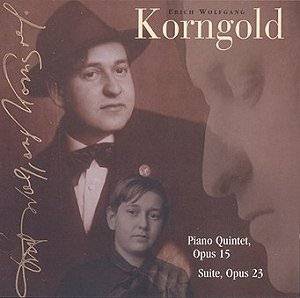
This is by far the most impressive Korngold chamber disc I have heard and it attracts a warm recommendation.
A decade divides these two works; a decade which injected a damask character into the sunny pastures of Korngold's youthfully joyous music. The later Suite (a work commissioned, after the L-H concerto, by Wittgenstein) is in five movements. It breathes the experience of disappointments and presentiments of an oppression that was soon to drive Korngold into the sunny but commercially grasping arms of Hollywood. It is not all struggle and conflict although those qualities are certainly there. The Lied and Walzer are a lighter relief; the former a nugget of winsome beauty. They divide three movements afflicted with a sombre romantic striving. The clouds part at least partially for the still emotionally complicated finale.
That finale and its typically voluptuary saturation lead into the film music soon to make Korngold's name internationally and ironically break his musical reputation (at least until the more enlightened 1980s). The 1921 Quintet starts in rapturously plunging melody - a mood sustained throughout the movement. At 4.34 the high harmonics of the violin establish a dewily lachrymose garden magic. The music is in no sense fragile and one only observes that (rather like the Bax Piano Quintet dating from six years previously) the wonderfully inspired music is straining at the chamber medium signalling Korngold's natural predilection for the orchestra. The central adagio is a tissue of tinsel (5.40) abraded by fevered and sometimes bruising visions (9.20). In this Korngold achieves some of his most lovely music. The work is influenced by Rosenkavalier and is desperately impressive. The panache and gamin playfulness of the finale in which ideas rain down in profusion is captivating. Perhaps strangely it is this work rather than the later Suite that predicts the lush Hollywood scores of the 1940s. Certainly there were more than a few occasions when visions of Robin Hood and The Sea Hawk hove in view.
The notes (English only) are good, in large type, and the photographs courtesy of the Korngold Society of Hamburg, are well worth having. I wondered at first whether the playing would be idiomatic. With an assemblage of names would the whole affair be rather unfocused? In fact all concerned seem musically at one with each other.
The CD will be wanted by all who have assiduously collected Korngold during the CD era. In addition those whose interest is chamber music of the early-mid twentieth century will want this disc for the valuable light it throws on musical activity in Europe at that time.
Reviewer
Rob Barnett

And another view from Gary Dalkin
This enterprising album, which offers two contrasting chamber works from the young Korngold, may come as a surprise to those only familiar with the composer's famous film scores, or perhaps with his grand concert works, which in any case often bear marked similarities to his film music.
The Piano Quintet was begun shortly after Korngold's great success with his opera Die tote Stadt, and completed in 1921 when the composer was still in his early 20's. Dedicated to his friend, the sculptor Gustinus Ambrosi, the three movement work lasts, in this performance, just over half-an-hour; Korngold himself was the piano soloist for the Hamburg premiere in 1923. The opening movement is concentrated in its distilled lyricism, offering a density of invention quite different to the later, inevitably more directly melodic film music. One really startling moment comes when a passage of intense melancholy abruptly takes a detour through brief atonal piano writing and caustic strings. It lasts less than half-a-minute before tonality triumphs and the movement ends, but from Korngold it is shocking that it is exists at all. In the following 'Adagio' the piano pushes at the edges of tonality in a questing, urgent exploration towards a most affecting melody. This is music with a youthful uncertainty, wanting to resolve into absolutes, yet asking introspective, self-doubting questions along the way. When a 'big tune' finally arrives at '5:20' Korngold almost immediately strips it down to the essentials of a stark mournful line, before rising to a peak of angst. The material is derived from Korngold's own Songs of Farewell, most particularly the third song of the set, 'Moon, thou Riseth Again' and the music certainly contains the hallmarks of youthful emotional torment.
The 'Finale' opens with a bold statement by the violin, joined by confrontational block piano chords and leading to a characteristically Jewish violin melody which in turn develops into a spry rondo. A dazzling sequence of themes spin through rapid variations, before the work is tied together with a return opening melody.
The compactness of the material demands the fullest attention, as the young Korngold obviously had so much to say he almost risks spilling it out all at once. Listening to this music one almost wishes the composer had taken more time to develop his melodies, rather than rushing on headlong like a butterfly, turning first this way then that, always beguiling, but perhaps ultimately achieving less than a more direct route might have obtained with more economy. Less is more may well apply, though youth has always had more energy than time to spare.
The Suite, Opus .23 (for 2 violins, cello and piano: left-hand) dates from 1930, and in the nine years between the two works it is obvious that Korngold has matured into a composer of considerably more control and authority. Here the pacing is more measured, the use of piano against strings more carefully structure to achieve precise emotional effects. By saying one thing at once, Korngold makes sure we hear him clearly. The romantic melodies are stated with great clarity, each instrumental line evidently part of the overall structure such that the musical architecture is revealed in clean lines and strong design. In five movements, the work is almost a concentrated symphony, and could perhaps have been re-orchestrated into symphonic form had Korngold chosen to do so. Certainly the development is more 'symphonic' than in the Quintet, though the economy of instrumental forces has the advantage of allowing us to appreciate Korngold's musical invention without the distraction of his customary rich orchestration. Here, rather more so than in the earlier work, the film music aficionado will find pointers to the style of the great romantic melodramas Korngold scored in the following two decades.
The Suite was Korngold's second commission for the noted one-armed pianist Paul Wittgenstein - the first had been a piano concerto in 1923 - and was premiered by Wittgenstein Vienna in October 1930. Korngold runs the gamut from fugue to waltz, with controlled dissonance set against a slow movement based upon the composer's own beautiful 'Was du mir bist?' from the Opus 22 lied, and again a finale spinning variations from an opening rondo. This time the result is more appealing, for rather than demanding our attention with an onslaught of invention, Korngold's writing makes every phrase a pleasure.
Both pieces on this disc require playing of a high order, and the informal ensemble respond with virtuoso performances. The booklet (which also features some beautifully reproduced photographs of the composer) gives informative notes both about the music, and about the musicians, who although apparently not a permanently established group, all hail from the Washington D.C. area. Cellist Steven Honigberg is clearly the driving force behind the recording, for the booklet lists four other albums featuring his artistry, and he is also the producer of this current release. With engineer Ed Kelly he has achieved a very clear and unforced sound, with the instruments defined in a natural soundstage making following the interplay between the parts delightfully easy. The balance is good, and each instrument has a real sense of presence. The fact that it has been produced to the highest standards is further indicated by HDCD encoding, enabling those with the appropriate audiophile equipment to benefit from the best possible sound quality.
The Piano Quintet is full of youthful passion, while the Suite is certainly a stronger, more mature work. Taken together they present not only a less well known facet of a fine composer whose 'serious' work is only now coming to be known, but offer the opportunity to see the development over a decade of a composer approaching two rather different works for comparable forces. This is not a release to recommend to the hardcore film music buff, for apart from this not being film music, there is little here which sounds directly like Korngold's later soundtrack work. However, for the more adventurous film music fan, and for those interested in a range of classical as well as film music, this is a very interesting and rewarding album.
Reviewer
Gary S. Dalkin

MAHLER: "Titan - eine Tondichtung in Symphonieform" *(1893 Hamburg Version of the First Symphony) Piano Quartet in A Minor **(movement) *Norrkoping Symphony Orchestra conducted by Ole Kristian Ruud **Mats Jansson and Members of the Holmen Quartet
Simax PSC 1150
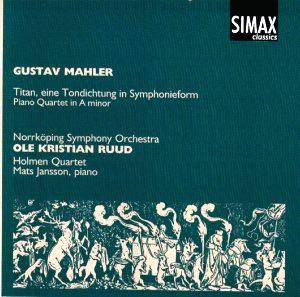
As the only recording currently available of this earlier version of what we know as Mahler's First Symphony this is an important release. The First had a difficult birth. It underwent a number of revisions before reaching the version usually performed and recorded today. The precise history need not detain us since it's a complex and by no means completely solved puzzle, but suffice it to say that what we have here presents broadly the penultimate stage in the work's development heard in Hamburg in 1893. It carried the title "Titan, Symphonic poem in the form of a symphony" and had five movements organised in two parts.
In the event it was not a success so Mahler submitted it to one final revision which consisted in the expansion of the orchestration, the dropping of the title (so recording companies and concert promoters note that the First Symphony should never be called "Titan") and, most important of all, the discarding of the second movement, an andante entitled "Blumine" to then give us the First Symphony with which we are most familiar today. Occasionally recordings do appear of the final version with "Blumine" dropped back into its old place, but this practice should be stopped as it creates, in effect, a hybrid never intended by the composer. If "Blumine" is to be played as part of the larger work in which it originally featured it should only be done, as it is here, "in situ" with the original orchestration from the version prior to the one we know best.
There are many more questions raised by this recording, of course. Not least the accuracy of the published orchestral parts that would have been used and their relationship to the manuscript at Yale University to which provenance is claimed. The latter is itself by no means a clean set of documents either, a fact the notes fail to mention. But discussion of all these fine points are beyond the scope of this review. Having made these caveats clear I think we can rely on this recording taking us close to what Mahler presented in Hamburg in 1893, though it cannot be said with confidence to be exactly what he conducted.
The differences between the First Symphony we are familiar with and this 1893 Hamburg version may not seem all that great on first hearing but they are significant. If you know the First Symphony well I recommend making a direct comparison between your favourite recording of that and this one under discussion. The performance itself is not one filled with special insights, however. Were it not for the fact that this is the only recording available of the 1893 version it would not deserve to make much of a splash at all. No composer quite exposes the second rate in orchestral playing like Mahler and the Norwegian orchestra never rises above that level as they give us a workmanlike, but ultimately uninspired, performance with strings rather undernourished, brass on the thin side and woodwind failing to really make any great impression.
The first movement gets a straightforward performance but with a reasonable stress on the lyrical rather than the dramatic. No bad thing when performances of this music are often weighted down with too much emotional baggage. Note that, unlike the symphony's final version, this earlier version carries no exposition repeat in the first movement. The performance of the second movement, "Blumine", is dreamy, slight and nowhere near the deep analysis Benjamin Britten submitted it to in its first modern performance at Aldeburgh in 1967. In the third movement there is a nice slowing down for the Trio where the use of clarinet with horn is one of the changes in orchestration you will notice. The fourth movement, the familiar funeral march with the "Frere Jacques" canon, is conventionally paced and with the slightly thinner scoring you can perhaps hear why it was this movement that so shocked Mahler's first audiences. The inability of the orchestra to really rise to the occasion means the last movement doesn't bring the high voltage it can boast in recordings of the more familiar final version. The big string theme is rather four-square too but I think you can hear well enough the differences that exist between this and Mahler's final thoughts which will be, after all, the principal reason for wanting to own this recording.
This is a release that ought to be on the shelf of anyone interested in this composer's work. While we continue to await a recording of the score by one of the great orchestra/ conductor partnerships it will serve us well enough. It also carries an appropriate coupling in the only movement that has survived of one of Mahler's very earliest works, his Piano Quartet. This receives a fine performance, especially the opening of the piece which contains its most striking music. Not really any hint of greatness to come but a fragment from the master's workshop that is always of interest and adds value to the disc.
Reviewer
Tony Duggan

MAHLER: Symphony No.7 London Symphony Orchestra conducted by Michael Tilson Thomas
RCA Red Seal 09026 63510 2
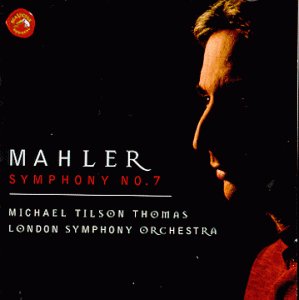
If you are looking for a recording of Mahler's Seventh that stresses the expressionistic, modernist side to this work this recording may not be for you. If, however, you want a central interpretation that will last you longer than those which go in for thrills and effects you might look no further because what you will hear is a superb presentation of the exotic sounds and colours of this work that is never at the expense of the bigger symphonic picture.
Michael Tilson Thomas's interpretation of Mahler's Seventh Symphony is a near-perfect balance between the work's inner details and its outward form: heart balanced with head.
This latter point can be heard most strongly in the first movement where his unerring grasp of the difficult tempo relationships between each section never reduces things to the rag-bag of episodes it can sometimes sound under more interventionist hands. This movement has clearly been planned and thought through to a quite remarkable degree. Tilson Thomas does give himself enough space for us to hear the remarkable instrumental detailing, however. For example, I loved the ripe tenor horn of Ian Bousfield really "roaring", as Mahler asks, also the translucent texturing of the woodwinds against the strings in so many parts of the movement, and then the way Tilson Thomas achieves a welcome and unusually dark-grained quality to the lovely central section where Mahler's transfigured nightscape really gets under the skin. Don't get the idea that the first movement in this recording is all limpid beauty and dark contemplation. When he needs to, Tilson Thomas can be tough, driving the music on with more emphasis on the snap of the marches that cross and re-cross this movement than we are sometimes used to. These marches never sound rushed when played like this, which I have heard them sound on other occasions, and that's another tribute to the grasp of this movement shown by a conductor who really can deliver weight and propulsion at the same time. Towards the end the march brings real passion, hammered home by the well-caught percussion rounding out an interpretation that stays in the mind long after the music has stopped. The poised, refined playing of a beautifully prepared LSO and the rich recording, with just enough air around the instruments, are undoubted allies in all this as they will remain right the way through the rest of the work. Grand and imposing, intimate and searching, this first movement is as near a complete picture of this remarkable piece as the bounds of symphonic argument can hold. You can also admire the feeling of the march's tread in the second movement but, as before, this is not the whole story and the way Tilson Thomas identifies a Wunderhorn link in some of the solo accompaniments is most impressive. This is a spacious conception of the movement but one never lacking in interest through Tilson Thomas's fine ear for detail, his imagination and his ability to really take us into the heart of music that is, for some, Mahler's "symphony too far". This is especially evident in the really idiomatic quality to the interludes that emerge with a really tawdry tone, slinky and feline.
The nightmarish third movement has the right amount of menace balanced by a veil of fantasy, though I do think Tilson Thomas might have been a little more abandoned, even taking into account his stress on symphonic balance. A very relative disappointment only, but after hearing recordings by Rattle and Scherchen, for example, anything is going to sound tame. This does not prevent Tilson Thomas and his orchestra presenting us with some splendid effects here, especially the col legno snaps of bows against strings. I also thought he showed rare understanding of the profound difference in the Trios of this movement, islands of uneasy calm in the dreamy maelstrom. In the lovely fourth movement, the second of the two Nachtmusik, the emphasis is on warmth and noble ardour, assisted greatly by emphatic portamenti from the strings which inject just the right amount of tension into the proceedings and also the impression that this is music out of an essentially sick society.
Too often the last movement's delivery spoils a performance of this work, but that is not the case here. To crown a performance of this triumphantly disjointed work the last movement must be given with absolutely no doubts as to its greatness otherwise it can sound out of place. It is good to report Tilson Thomas avoids this. Under him this is grand, warm, affirmative, essentially ceremonial music: the return to day Michael Steinberg points to in his notes where a spiritual journey out of darkness and into the light is rightly stressed across the whole symphony. This last movement also shows that Tilson Thomas knows when to smile - not always the case with Mahler conductors today. As with the first movement, Tilson Thomas shows an unerring sense of structural integrity with the whole knitting together, especially towards the end where the crowning of the work with bells is liberating and fulfilling.
With his consummate ear for the unique sounds of this work matched to creative restraint and structural integrity, all harnessed to great flair and concentration, Tilson Thomas delivers a new Seventh to treasure. Could we ask more ? Well, perhaps a "live" recording would have given us an extra touch of panache in the last movement, but that can be said of most studio versions. Though essentially a central view of the work, Tilson Thomas proves his approach pays great dividends. Warmly recommended in all departments.
Reviewer
Tony Duggan

MAHLER: Das Lied Von Der Erde Jon Villars (Tenor) Michelle DeYoung (Mezzo) Minnesota Orchestra conducted by Eiji Oue
Reference Recordings RR-88CD
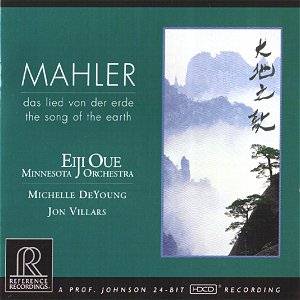
The range of the sound on this recording is evident from the beginning with a rich and reverberant audio picture for Jon Villars to then enter revealing a voice of honeyed lyricism. It's not an especially varied performance that he gives of the first song, however. As will prove in the whole of his contribution, his stress is on beauty of tone and lyrical delivery: the singer-actor rather than the actor-singer. The "Dunkel ist das leben" refrains that punctuate the first song, for example, are not delivered with the world-weary quality others rightly find and I confess to missing that somewhat, but others will prefer this "song" sung rather than "acted". In the expressionist centrepiece, where the singer has a nightmare vision of an ape cavorting over graves in the moonlight, we come to an acid test for the singer whatever his approach. Villars never sounds strained as some can which, though a tribute to his artistry, does mean we are robbed, perhaps, of the added element of manic drama that James King, for example, finds for Bernstein. But I enjoyed the way Eji Oue and the orchestra rounded off the song with an emphatic crunch of exclamation at the end, a rhetorical full stop, reminiscent of the same moment under Bernstein again.
This will prove a rare piece of concert hall theatre from this conductor as the opening of the second song confirms textural refinement to be Eji Oue's prime concern. Right the way through, the varnish on Mahler's "chinoiserie" is much thicker than under most conductors and this is certainly aided by the rich upholstery of the recording. This approach may be a problem for those who, like me, think the whole work, and this second song particularly, should allow for a slightly more astringent sound palette, but there's no doubting the excellence of what is achieved. Michelle DeYoung herself seems set further back than her partner and her's is also a lighter voice than we are sometimes used to in our mezzos and contraltos. But her awareness of the meaning of the words is clearly evident from the start and more than makes up for any slight lack of the real contralto's tone. Her description of the little lamp burning out with a splutter, for example, is exemplary though doesn't quite approach the depth of meaning it has under Janet Baker (for me the finest female exponent of these songs) or Christa Ludwig. "Sonne der liebe....", which is the first time any real warmth enters the song, reveals the full glory of DeYoung's voice, again sure of her words and their meaning.
The accompaniment to the third song gets a little lost in the large acoustic space suggesting to me a more intimate production might have helped this performance even more. But I must add that this is marginal and, as elsewhere, the gain in richness and the feeling that you are present at a performance more than compensates. Jon Villars alters his tone in this song as he should, though, again, there are other singers who manage an even greater sense of involvement. In the fifth song he brings a real element of fantasy to the central stanza and the arrival of Spring. Again you cannot praise the beauty of his singing too highly. Other singers might act out the part, becoming more intoxicated as the song wears on, (like Peter Schreier), but that would not be in keeping with the more patrician style Villars has established and which is just as valid and engrossing.
In the fourth song Michelle DeYoung really makes us see through her eyes the girls picking flowers by the river. Then in the central section, where she has to describe the bursting on to the scene of the young men on horseback, she acquits herself better than many in what must be a passage singers approach with dread. She is helped here by a very bouncy accompaniment from Eiji Oue and the orchestra, depicting very frisky horses indeed. Then in her delivery of the final lines that start "In the flashing of her large eyes, in the darkness of her passionate glance....." Miss DeYoung projects all the feminine allure you could want. No wonder the boys on horseback stopped for a look.
The final song, "Der Abscheid" ("The Farewell"), crowns this fine performance admirably. It finds DeYoung at her most persuasive and her conductor sustaining the longest of spans with superb concentration right from the start. A special words of praise for his orchestra here. It sounds like one take and all the better for that.. There is a splendid sense of pregnant anticipation in the opening passages, for example, with the all important lower registers of the orchestra caught beautifully by the recording, as they are all the way through. Then with what aching beauty are the most intimate sections put across, especially when set against a funeral march interlude more impressive for its noble restraint. The passage that leads back to the re-appearance of the singer put me in mind of Bruno Walter's "live" recording in Vienna in 1936, and there can be no higher praise than that.
So this is a recording of real stature, one that I think will repay repeated listening. Perhaps one of those recordings which, like Horenstein's, reveals its secrets over time, which means I'm not yet certain whether it will challenge the very greatest before us - Klemperer, Horenstein, Sanderling, Bernstein and Walter - but it seems in with a chance. If it does fall short, it does so because of its stress on textural purity and beauty of tone by both orchestra and soloists at the expense of some psychological depth. But here I may be damning with feint praise, especially if this kind of approach is what you desire and think appropriate. If it is, buy with confidence.
Reviewer
Tony Duggan

MASCAGNI: Cavalleria Rusticana LEONCAVALLO: I Pagliacci. Dennis O'Neill, Nelly Miricioiu, Philip Joll, Diana Montague, Elizabeth Bainbridge. Alan Opie, Peter Bronder, Rose Mannion, William Dazeley, Paul Parfitt, Peter Hall. Geoffrey Mitchell Choir, The Peter Kay Children's Choir, London Philharmonic Orchestra David Parry
Chandos Opera in English CHAN3005(2) 159m DDD.
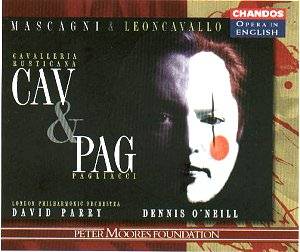
Although I do not wholly agree with the concept of Opera in English, there is no denying the fact that Chandos have a winner series on their hands, especially with this famous double-bill. Dennis O'Neill's status as one of the finest Italian lyrical tenors around puts him in the driving seat in this all-English production. In the 'Cavalleria' especially he is on top form with some lovely solo numbers and duets showing the full power of his match although it is also finely homespun and lyrical at the same time. The entry in 'What do you want Santuzza' is indeed thrilling although Miriciou's curse of 'Mala Pasqua' is feeble in its English counterpart, by now I had really began missing my Italian! With the choruses and Easter Hymn, you don't seem to mind much although the latter is infinitely more touching in its native language. There is nothing to fault the orchestra with though, their playing of the wonderful Prelude and Intermezzo is white-hot and they are constantly directed with exemplary panache by David Parry who shapes the final scene beautifully. All the roles are well sung although it has to be said that the Italian language is sorely missed in this most rustic of operas.
'Ahhhh…….hanno ammazzato compagne Turiddu'.
'I Pagliacci' suffers even more in this regard. You cannot fail to be thrilled by Alan Opie's wonderfully paced 'Prologue' but those words, they are almost a nightmare! It is obvious that this music was written to flow along the Italian verse but anyway, this is English. Dennis O'Neill is a splendid Canio, he sings the famous 'On with the motley' with beautiful tenderness and passion whilst Rosa Mannion's Nedda is also superbly characterized. William Dazely's Silvio is also marvelous, ranging from deep emotion to depression in admirable operatic character. For example, 'Ah, sei tu ben venga' is infinitely more dramatic than Ah it's you, You're welcome' almost as if a long lost friend has appeared. Countless other little comparisons may be cast but the end result is that I prefer Karajan's intimate and superbly paced account of this wonderful opera. The Intermezzo is beautifully played and the recording is also rich and vivid in the best Chandos tradition. The contradiction in it all is that Chandos provide full notes in about five languages whilst the libretto is in English only! Sumptuously packaged, those died in the wool Imperialists will obviously applaud this issue but you should always listen to the originals, it's like a whole new world.
'La commedia e finita'
Reviewer
Gerald Fenech
Performance
Sound

NIELSEN: Symphony No. 3, 'Espansiva', Symphony No. 5, Saul and David: Prelude, Act II. Danish State Radio Symphony Orchestra. Erik Tuxen.
Dutton CDK1207 76m ADD (Rec 1946/50).
Save around 22% with
Crotchet
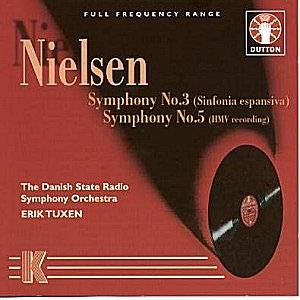
At long last, these classic recordings are available again! We have had the early Jensen sets on Dutton for some time now and it was high time that Tuxen's legendary coupling was to see the light of day. I have played this disc over and over again and was consistently bowled over by the dramatic intensity and pungency of the 'Espansiva' in particular. Tuxen's dramatic account is surely the prime recommendation of this work and should hold the standard for some time to come. I compared it with a live 1959 performance by Thomas Jensen and the DSNRO, and the Tuxen came out consistently on top especially in the sublime Andante pastorale, a miracle of refinement with a substantial contribution from the soloists, Inger Lis Hassing and Erik Sjoberg, both singers of ethereal beauty. The Allegro Finale is equivocally thrilling in its intensity and passion, a tribute to the postwar magic of the DNRSO and a memorial to the instinctive feel of Tuxen for Nielsen's music.
The Fifth is another superb performance. Here the competition is quite fierce, one cannot forget Georg Hoberg's far-out 1933 version and Thomas Jensen's superbly recorded 1954 version for Decca (also on Dutton). Tuxen is marginally slower than the latter which is my benchmark recording. He creates a palpable sense of tension and irresistible momentum and the playing of the orchestra is indeed magnificent throughout. The Adagio non troppo benefits from greater clarity and vision particularly in the two big climaxes that conclude the movement, a life-affirming permeation of faith and hope that is the kernel of Nielsen's music. And with the massive Finale, Tuxen and his orchestra are indeed on home ground, their sense of precision is disarming whilst the power and passion of the music carry all before it. I fail to understand EMI's flagrant denigration of this wonderful recording which is indeed a 'Great Recording of the Century'. Well, thanks to Mike Dutton who has done a superb job in remastering these originals and creating recordings that are indeed models of their kind. The short 'Saul and David' Prelude is indeed beautiful and makes a welcome addition to the big guns. You might be buying the new Schonwandt and Bostock cycles but this issue is the missing link to the elusive Danish recordings that blazed the trail for this wondrous composer and which are essential, indeed indispensable additions to the discography of Carl August Nielsen.
Reviewer
Gerald Fenech

THE ESSENTIAL NIELSEN SYMPHONIES
Symphony No. 1: Danish State Radio Symphony Orchestra: Thomas Jensen. Decca LXT 2748 June 1952 Dutton Laboratories CDLXT 2502.
Symphony No. 2 'The Four Temperaments Danish State Radio Symphony Orchestra Thomas Jensen EMI HMV Z 7000-3 October 1947. Dutton Laboratories CDCLP4001
Symphony No. 3 'Espansiva'. Danish State Radio Symphony Orchestra Erik Tuxen Decca AK2161-5 October 1946 Dutton Laboratories CDK1207
Symphony No. 4 'The Inextinguishable' Danish State Radio Symphony Orchestra Launy Grondahl. EMI HMV DB2015-60 August 1951. Dutton Laboratories CDCLP4001
Symphony No.5. Danish State Radio Symphony Orchestra Erik Tuxen/Thomas Jensen EMI HMVZ7022-6 April 1950/Decca LXT 2980 April 1954 Dutton Laboratories CDK1207/CDLXT2502.
Symphony No. 6 'Sinfonia Semplice' Danish State Radio Symphony Orchestra Decca LXT 2749 June 1952 Danacord DACOCD 351-53 (Transferred from TONO pressings).
Footnote:
The final recording of the Sixth is somewhat blurred and not as clear as the impeccable Dutton transfers of the contemporary First. One hopes that some Decca pressing or master may be found and used for the transfer of this unique recording. I would also add as supplements, Jensen's pioneering 1944 unpublished 'Four Temperaments' and the 1933 Georg Hoberg version of the Fifth to the awesome shortlist above. Both are available on Danacord Vol 6 of the Historic Carl Nielsen collection. I will also be discussing these recordings in greater detail when publishing a paper on the Nielsen symphonies that will be exclusive to Music on the Web readers.
PAUL PARAY (1886-1979) Symphony No. 1 in C (CD premiere), Mass for the 800th Anniversary of the Death of Joan of Arc Lorna Haywood, soprano; Terry Patrick-Harris, mezzo soprano Joseph Harris, tenor; Josik Koc, bass-baritone Royal Scottish National Chorus Christopher Bell, Chorus Master Royal Scottish National Orchestra/James Paul
recorded 14-15 September 1996 at City Hall, Glasgow, Scotland REFERENCE RECORDINGS RR-78CD [65.57]
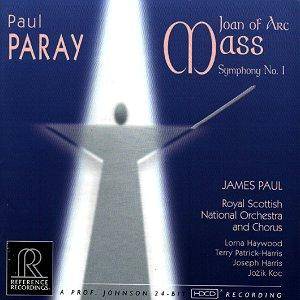
The French composer-conductor, Paul Paray, was best known in the United States as the conductor of the Detroit SO (1952-63). He was also a multiple-prize-winning composer of international repute. His own Mercury recording of the Joan Of Arc Mass has been a connoisseur's favourite for many years.
In the present disc we meet the CD premiere of his Symphony no. 1 in c and the first modern recording of the Mass.
What to expect: tuneful and melodious music out of the schools of Franck, Fauré and Chausson.
The symphony dates from three years after the mass. It was written in 1934. Its roots are in the Bizet and Franck symphonies but with romantic and mildly impressionistic elements from Dukas. There is none of Poulenc's frivolity in the emerald green elegance of the first movement although a nobility (quite strongly reminiscent of Elgar 2) strides through the pages to return in the fourth movement. The second movement has a tentative succinct eloquence. The allegretto (III) is at the pace of any similar movement in a Bruckner symphony and some of the string writing had the string cascades and cradle-rocking hauntings of Franz Schmidt (second and third symphonies). The finale is a bacchanal of boisterous joy and that very same Elgarian nobility that stalks the first movement. The closing pages mix in a military set to the jaw. This work makes me eager to hear the second (1940) and third symphonies. Any chance Mr Paul and Reference?
The Mass is quite simply a gem. Its lineage goes back to the Fauré Requiem. The Kyrie has all the soft beguiling of perfumed and exotic plumes. It rises from this sybaritic possession to some operatic singing for the soloists (Verdi's Requiem) and a grand processional for brass in their most commanding mode. The long Gloria is another delight. It is romantic and exciting: swirling and wondrously stomping. The work spirals down from the heights to a reflective Miserere. The Quoniam has all the candle-lit and incense absorbed splendour of the Saint-Saens Third Symphony. The movement ends in tolling and swinging triumph . The Sanctus is memorably celebratory in a vein rather like Walton but with a Gallic accent. There is a blessed Benedictus and the Agnus Dei is a peaceful and winding benediction. A discovery and one likely to appeal especially to lovers of the Fauré Requiem, Saint Saens Third Symphony and Howells' Hymnus Paradisi.
Very good documentation and recording is up RR's usual very demanding standards.
An easy recommendation. Don't miss another of RR's successful adventures off the well-beaten and predictable track.
Reviewer
Rob Barnett

Return to [Part 1] [Part 2] [American Naxos part 1] [American Naxos part 2] [January Index]
Return to Index of Classical Reviews |
|||||